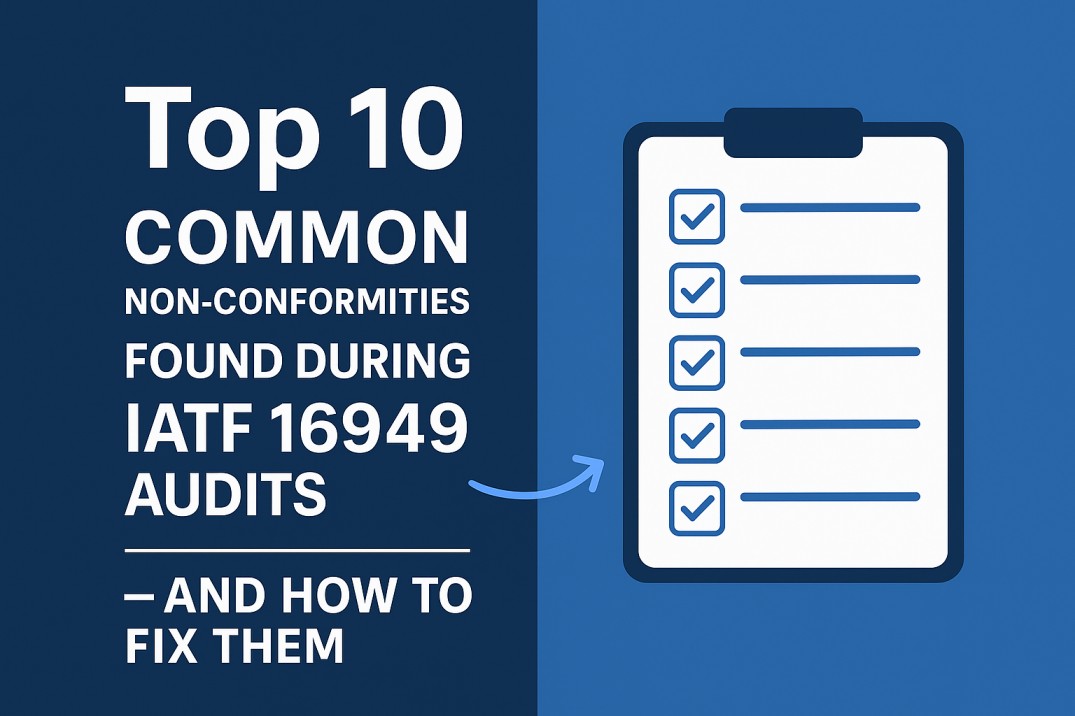In the competitive world of automotive manufacturing, consistent quality and compliance aren’t just expectations — they are survival essentials. Every Tier 1 and Tier 2 supplier knows the weight an IATF 16949 audit carries. It determines not only certification but also business continuity with OEMs like MSIL, Honda, or Tata Motors.
Yet, many capable organizations face non-conformities during audits — often not due to lack of intent, but due to weak implementation, documentation lapses, or missed linkages between processes.
In this blog, we’ll explore the top 10 common non-conformities found during IATF 16949 audits — and more importantly, how to fix and prevent them.
Understanding Why Non-Conformities Occur
Before addressing the “what,” it’s important to understand the “why.”
Non-conformities (NCs) typically arise when:
- Systems exist on paper but are not implemented effectively.
- Procedures are outdated and not aligned with current practices.
- Employees are unaware of system requirements.
- Internal audits or management reviews are treated as routine exercises.
The IATF 16949 standard demands process-based thinking, risk management, and continual improvement — not just compliance. Understanding these principles helps in addressing the root cause of non-conformities instead of firefighting during audits.
Top 10 Common Non-Conformities in IATF 16949 Audits
Below are the most frequently observed findings during third-party or customer audits in the automotive industry, along with corrective tips based on real consulting experience.
1. Poor Control of Documents and Records (Clause 7.5)
Issue: Outdated or uncontrolled documents, missing approval signatures, and obsolete versions found in use at workstations.
Fix:
- Maintain a master document list with version control and approval status.
- Use electronic control systems or unique document codes.
- Train operators to verify the latest revision before use.
- Audit document control regularly.
2. Ineffective Internal Audits (Clause 9.2)
Issue: Internal audits are done superficially or without identifying process performance issues.
Fix:
- Conduct process-based internal audits — not checklist-only audits.
- Include effectiveness verification, not just compliance checks.
- Rotate auditors between departments to avoid bias.
- Track closure of audit findings with evidence.
3. Weak Root Cause Analysis and Corrective Action (Clause 10.2)
Issue: Repeated NCs occur because corrective actions are temporary fixes, not systemic solutions.
Fix:
- Apply structured methods: 5 Why Analysis or 8D Problem Solving.
- Focus on eliminating causes, not just symptoms.
- Verify effectiveness after implementation — e.g., through data trends or follow-up audits.
4. Lack of Evidence for Risk-Based Thinking (Clause 6.1)
Issue: Risk management is often limited to FMEA, without linkage to process planning or action plans.
Fix:
- Identify risks and opportunities at the process level.
- Maintain a Risk Register covering process, product, and supply risks.
- Review risk status in management reviews.
5. Poor Linkage Between Control Plan and Process Flow (Clause 8.5.1)
Issue: The Control Plan doesn’t match the actual process sequence or updated customer requirements.
Fix:
- Update Process Flow Diagram (PFD), Operation Standard and Control Plan simultaneously.
- Verify that characteristics, inspection frequency, and control methods match reality.
- Ensure engineers and operators review revisions before implementation.
6. Calibration and MSA Deficiencies (Clause 7.1.5)
Issue: Equipment used for measurement is not calibrated on time or MSA studies are not updated.
Fix:
- Maintain a calibration schedule with alerts for due dates.
- Conduct periodic Gauge R&R and Bias/Linearity studies.
- Ensure “Out-of-tolerance” instruments are evaluated for product impact.
7. Incomplete Supplier Development and Evaluation (Clause 8.4)
Issue: Supplier performance is not monitored beyond delivery and quality; lack of documented evaluations.
Fix:
- Implement a Supplier Performance Scorecard (Quality, Delivery, Cost, Responsiveness).
- Plan periodic supplier audits or self-assessments.
- Document supplier development actions and feedback.
8. Ineffective Management Review (Clause 9.3)
Issue: Reviews done as a formality; inputs/outputs not linked to measurable improvement.
Fix:
- Follow the agenda as per IATF clause 9.3.2.
- Use data-driven presentation — customer complaints, process performance, audit trends, resource needs.
- Document action plans with timelines and responsibilities.
9. Inadequate Handling of Customer-Specific Requirements (CSR)
Issue: CSRs from MSIL, Tata, or Bosch are not fully integrated into QMS procedures.
Fix:
- Maintain a CSR Matrix showing how each requirement is addressed.
- Communicate CSRs to relevant departments (e.g., APQP, QA, Production).
- Verify CSR compliance during internal audits.
10. Poor Change Management (Clause 8.5.6)
Issue: Engineering or process changes made without customer notification or risk evaluation.
Fix:
- Establish a Change Management Procedure covering product, process, equipment, or supplier changes.
- Use a documented change request form with risk assessment and approvals.
- Inform customers and retain change records.
How to Prevent Recurrence and Build a Robust System

Addressing NCs once is not enough — sustainability is key. Below are proven strategies used by top-performing automotive suppliers.
Strengthen Internal Competence
Train your internal auditors, engineers, and team leaders on:
- Process approach and IATF clauses
- Core tools (APQP, PPAP, FMEA, MSA, SPC)
- Practical audit questioning techniques
Regular competency refreshers reduce dependency on external auditors and improve ownership.
Integrate QMS into Daily Operations
A system works only if it becomes part of daily work.
- Display quality objectives and key performance indicators at workstations.
- Use layered process audits (LPA) for ongoing compliance.
- Involve shop-floor teams in root cause analysis and improvements.
Use Data for Decision-Making
Instead of reactive firefighting, use trend data to predict and prevent issues:
- Rejection and rework trends per process.
- Supplier PPM trends.
- Audit NC recurrence data.
This supports Clause 9.1 — Monitoring, Measurement, Analysis, and Evaluation, ensuring decisions are fact-based.
Engage Top Management
Top management must review quality KPIs, customer satisfaction, and improvement status. Their involvement ensures accountability and resource allocation for system improvement.
Partner with an Experienced Consultant
External experts provide unbiased insights, training, and implementation support. A short gap assessment before certification or surveillance audits can save time, cost, and reputation.
Conclusion: Turning Audit Findings into Opportunities for Growth
Non-conformities in IATF 16949 audits are not failures — they are signals for improvement. Each NC, when addressed systematically, strengthens your organization’s processes and credibility with customers.
Engineers and managers who proactively identify and close gaps build robust systems that go beyond compliance — they create sustainable performance excellence.
If you’re preparing for an upcoming IATF 16949 audit or facing recurring issues in internal audits, it’s the right time to get professional support.
👉 Get in touch with Mukesh Kumar (mksharma.31@gmail.com), a QMS consultant with 25+ years of experience in ISO 9001, IATF 16949, and MSIL/MACE vendor system audits, serving Gurugram, Faridabad, Manesar, Dharuhera, and Bawal regions.
Let’s make your next audit a success — with confidence and zero surprises.
How to close the IATF 16949 Audit Non-Conformities on the NC Cara Portal

